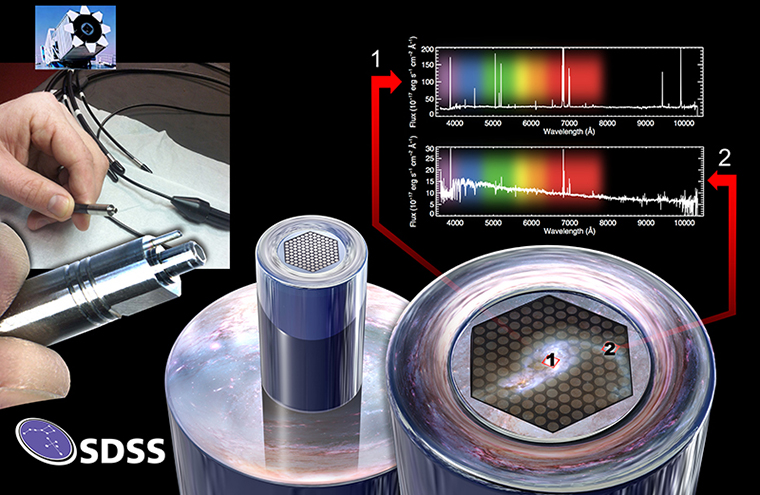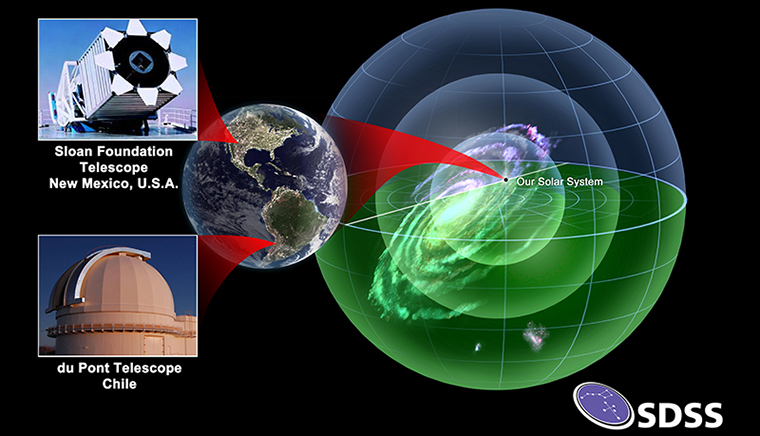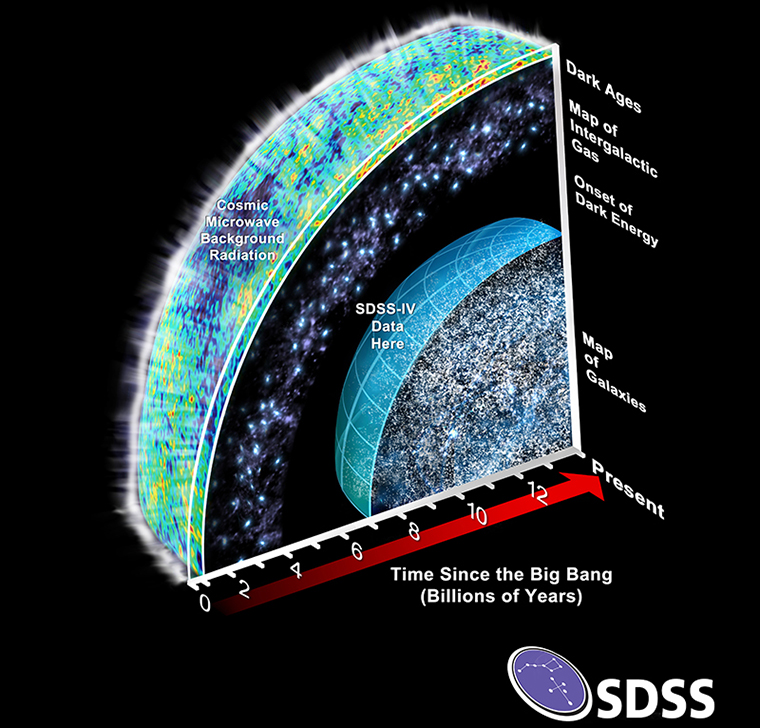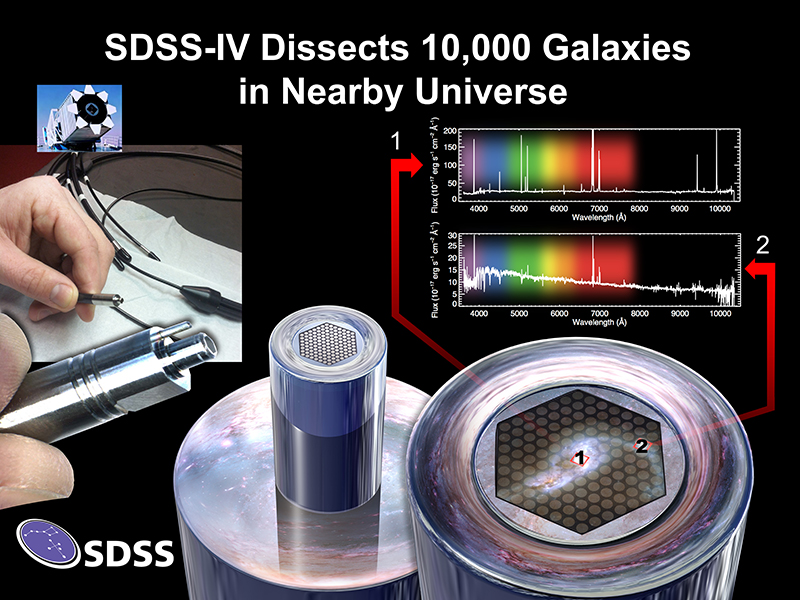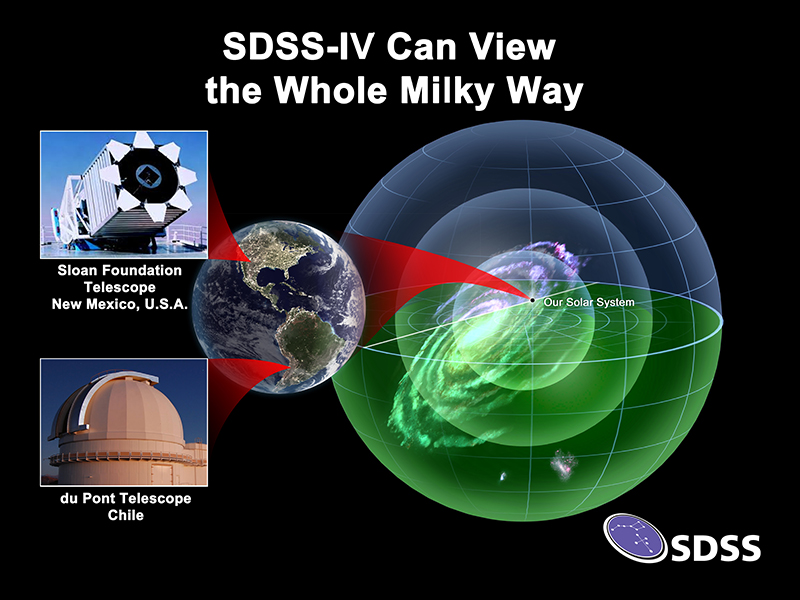Building on 14 years of extraordinary discoveries, the Sloan Digital Sky Survey (SDSS) has launched a major program of three new surveys, adding novel capabilities to expand its census of the Universe into regions it had been unable to explore before.
The left-hand side shows the Sloan Foundation Telescope and a close-up of the tip of the fiber bundle.
The bottom right illustrates how each fiber will observe a different section of each galaxy. The image (from the Hubble Space Telescope) shows one of the first galaxies that the new SDSS has measured.
The top right shows data gathered by two fibers observing two different part of the galaxy, showing how the spectrum of the central regions differs dramatically from outer regions.
Credit: Dana Berry / SkyWorks Digital, Inc., David Law, SDSS Collaboration
Hubble Space Telescope image credit: NASA, ESA, the Hubble Heritage (STScI/AURA)-ESA/Hubble Collaboration, and A. Evans (University of Virginia, Charlottesville/NRAO/Stony Brook University)
Available by FTP: 300 dpi JPG version
- Explore the compositions and motions of stars across the entire Milky Way in unprecedented detail, using a telescope in Chile along with the existing Sloan Foundation Telescope.
- Make detailed maps of the internal structure of thousands of nearby galaxies to determine how they have grown and changed over billions of years, using a novel optical fiber bundle technology that can take spectra of each different part of a galaxy at once.
- Measure the expansion of the Universe during a poorly understood five-billion-year period of the Universe’s history when Dark Energy started to drive its expansion, using a new set of galaxies and quasars.
SDSS is a collaboration of more than 200 astronomers at more than 40 institutions on four continents and incorporates telescopes in both the Northern and Southern Hemispheres. With these two telescopes, the SDSS will be able to see the entire sky for the first time.
The new phase of the SDSS will provide a vast new database of observations that will significantly expand our understanding of the nature of the Universe at all scales, from our own galaxy to the distant universe. In our galaxy, the new SDSS will see hundreds of thousands of individual stars, including stars that were born at the birth of the Milky Way and stars born in the past few million years, just yesterday in cosmic terms. Measuring the compositions, positions, and motions of individual stars will reveal how the Galaxy evolved from the distant past to today.
“Over the last fourteen years, many people have used SDSS data to make numerous discoveries that have revolutionized astronomy,” said Michael Blanton of New York University, the director of the new survey. “We have mapped the large-scale structure of the Universe, traced out previously unknown structures in the Milky Way, and made unanticipated discoveries from asteroids in our own Solar System to the most distant quasars.”
This phase will complete the picture. In addition to the Sloan Foundation 2.5-meter Telescope in New Mexico, SDSS will use the 2.5-meter Irénée du Pont Telescope at Las Campanas Observatory, high in the Chilean Andes and home to the clearest skies on the planet. In addition to completing our full study of the Milky Way, the du Pont telescope will also observe stars in the nearby Magellanic Clouds, giving astronomers a better understanding of the Milky Way’s immediate environs.
SDSS-IV will extend its reach by using both the Sloan Foundation Telescope at Apache Point Observatory and the du Pont telescope at Las Campanas Observatory in Chile, as shown on the left.
Because of the orientation of the Earth’s axis relative to the disk of the Milky Way, the northern telescope will observe a very different part of the Milky Way (shaded in blue) than the southern telescope (shaded in green), which will have an excellent view of the galactic center regions. The nested spheres show the range of distances from the Sun that the survey of the Milky Way will reach, depending on survey strategy and the density of stars and dust along the line-of-sight. Some observations will reach to the innermost sphere, while the deepest observations will extend to the outermost sphere and our neighboring dwarf galaxies, the Magellanic Clouds, shown at the bottom of the image.
Credit: Dana Berry / SkyWorks Digital, Inc. and the SDSS collaboration
Available by FTP: 300 dpi JPG version
“The SDSS has observed more than half a million Milky Way stars over the past fourteen years, which I call a good start,” said Jennifer Johnson of The Ohio State University, the Scientific Spokesperson of the new SDSS. “However, from the Northern Hemisphere, the Earth blocks our view of a quarter of the Milky Way, and mostly obscures our view of the galactic center. So there are literally entire regions of the Galaxy that the SDSS has yet to see.”
To take advantage of the scientific opportunities that the new SDSS offers, a number of Chilean universities have joined together for the first time to form a Chilean Participation Group which will be a member of the SDSS collaboration. “We are delighted to become a part of the new Sloan Digital Sky Survey, and we look forward to being active participants in this unique project to explore our Universe,” said Doug Geisler, a professor of astronomy at Universidad de Concepción and chairperson of the Chilean Participation Group Executive Committee.
But the Milky Way is far from the only galaxy that the new SDSS will examine. The new survey will employ innovative new technology to make detailed maps of thousands of nearby galaxies. Unlike nearly all previous astronomy surveys, which looked only at the centers of other galaxies, the new SDSS will measure light from all of the different parts of a galaxy. These better maps are made possible through a new technique of bundling sets of fiber-optic cables into tightly-packed arrays. These fiber arrays collect light from across the entire extent of a galaxy, enabling detailed spectral measurements of more than 10,000 nearby galaxies at twenty times the rate of previous surveys, which did one galaxy at a time.
“Our goal is to understand the ‘life cycle’ of present-day galaxies from imprinted clues of their birth and assembly, through their ongoing growth via star formation and merging, to their eventual fadeout after star formation ends.” said Matt Bershady, the Project Scientist of the new SDSS.
And the new SDSS will continue to improve our understanding of the Universe as a whole. It will precisely measure the expansion history of the Universe through 80% of cosmic history, back to when the Universe was less than three billion years old. These new detailed measurements will help to improve constraints on the nature of dark energy, the most mysterious experimental result in modern physics.
Previously, SDSS has mapped the universe across billions of light-years, focusing on the time from 7 billion years after the Big Bang to the present and the time from 2 billion years to 3 billion years after the Big Bang. SDSS-IV will focus on mapping the distribution of galaxies and quasars 3 billion years to 7 billion years after the Big Bang, a critical time when dark energy is thought to have started to affect the expansion of the Universe.
Credit: Dana Berry / SkyWorks Digital, Inc. and SDSS collaboration and
WMAP cosmic microwave background image credit: NASA/WMAP Science Team
Available by FTP: 300 dpi JPG version
Contacts
Matthew Bershady, University of Wisconsin, mab@astro.wisc.edu, 1-608-265-3392
Jennifer Johnson, The Ohio State University, johnson.3064@osu.edu, 1-614-292-5651
Douglas Geisler, Universidad de Concepción, Chile, dgeisler@astro-udec.cl, +56 41 220 3092
Jordan Raddick, SDSS Press Officer, raddick@jhu.edu, 1-410-516-8889
The new cosmology measurements will include the largest and most complete three-dimensional map of quasars to date, which will allow for precise measurements of the history of the Universe’s expansion in ways never before possible. Other programs within the new SDSS will follow up on galaxies seen by prior x-ray surveys, and will conduct the first systematic spectral study of variable objects, yielding a critical resource astronomers can use to identify the nature of many types of time-varying light sources discovered in previous surveys.
With new twists on its powerful instruments, a new outpost in the southern hemisphere, and the continuing generous support of the Alfred P. Sloan Foundation, the SDSS will remain one of the world’s most productive astronomical facilities. Science results from the SDSS will continue to reshape our view of the fundamental constituents of the cosmos, the universe of galaxies, and our home in the Milky Way.
Images
Click on each image for a larger version. High-resolution (300 dpi) versions of all images are available by FTP from ftp://ftp.astronomy.ohio-state.edu/pub/jaj/
The new SDSS will measure spectra at multiple points in the same galaxy, using a newly created fiber bundle technology.
The left-hand side shows the Sloan Foundation Telescope and a close-up of the tip of the fiber bundle. The bottom right illustrates how each fiber will observe a different section of each galaxy. The image (from the Hubble Space Telescope) shows one of the first galaxies that the new SDSS has measured. The top right shows data gathered by two fibers observing two different part of the galaxy, showing how the spectrum of the central regions differs dramatically from outer regions.
Credit: Dana Berry / SkyWorks Digital, Inc., David Law, SDSS Collaboration
Hubble Space Telescope image credit: NASA, ESA, the Hubble Heritage (STScI/AURA)-ESA/Hubble Collaboration, and A. Evans (University of Virginia, Charlottesville/NRAO/Stony Brook University)
Available by FTP: 300 dpi JPG version
SDSS-IV will extend its reach by using both the Sloan Foundation Telescope at Apache Point Observatory and the du Pont telescope at Las Campanas Observatory in Chile, as shown on the left.
Because of the orientation of the Earth’s axis relative to the disk of the Milky Way, the northern telescope will observe a very different part of the Milky Way (shaded in blue) than the southern telescope (shaded in green), which will have an excellent view of the galactic center regions. The nested spheres show the range of distances from the Sun that the survey of the Milky Way will reach, depending on survey strategy and the density of stars and dust along the line-of-sight. Some observations will reach to the innermost sphere, while the deepest observations will extend to the outermost sphere and our neighboring dwarf galaxies, the Magellanic Clouds, shown at the bottom of the image.
Credit: Dana Berry / SkyWorks Digital, Inc. and the SDSS collaboration
Available by FTP: 300 dpi JPG version
Additional Resource: The SDSS at Night Video
A time-lapse video of one night of operations at the SDSS telescope
Changing a cartridge, opening the enclosure, sunset, and nightly observing at the Sloan Foundation 2.5m Telescope at Apache Point Observatory, Sunspot, New Mexico.
During the night, an observer changes the cartridge to observe a new set of stars or galaxies roughly every hour. Each cartridge contains hundreds of fiber-optic cables plugged into holes in a large aluminum plate. Each fiber observes a single star or galaxy. The “bright time” observing is during full moon, the “dark time” is before moonrise, with the moon (not the sun!) rising shortly before the end of the video. The orange glow in the background is from the city of El Paso, Texas, 90 miles to the south.
The lights briefly shining through the telescope petals before and after cartridge changes are calibration sequences. We use different light sources to check that all parts of the instrument see light the same way and to compare the observations to known standards.
Credit: John Parejko (Yale University) and the SDSS collaboration.

